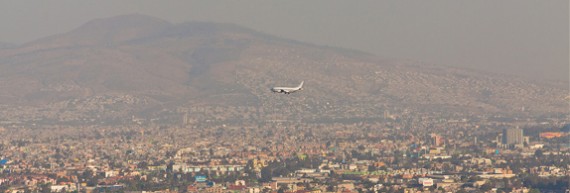Editor’s Note: This is the first of two stories by Frontera Norte Sur on outstanding border environmental issues in the Paso del Norte region, especially in relation to air quality.
Controversy was no stranger at the 57th meeting of the Joint Advisory Committee for the Improvement of Air Quality Paso del Norte.
Popularly known as the JAC, the advisory body brings together U.S. and Mexican government officials, private sector representatives, academics and civil society activists in the common goal of improving air quality in a dynamic and growing binational region.
Held in El Paso right before the long U.S. Memorial Day weekend, the five-hour, non-stop JAC meeting entertained lively discussion on a possible new power plant, regional air pollution reports, Texas and New Mexico toxics releases inventories, and the April 13 demolition of the old American Smelting and Refining Company (Asarco) smokestacks.
Veronica Carbajal, attorney for Texas Rio Grande Legal Aid, delivered a presentation on El Paso Electric’s plans to construct a natural gas-fired power plant on the east side of El Paso County in a place very close to the low-income Montana Vista subdivision, or colonia.
Carbajal’s office represents a group of residents, Rafael Carrasco and Far East El Paso Citizens United, who are challenging El Paso Electric’s air quality permit granted by the Texas Commission on Environmental Quality (TCEQ). With the closest home less than a mile from the proposed plant and El Paso city limits only two miles away, residents are concerned about air pollution, Carbajal said.
“We feel that there are possible non-attainment issues in the future, especially in regards to (PM) 2.5,” Carbajal said. According to the attorney, an air permit was fast-tracked by the TCEQ last year but is now in a contested case status because of the legal challenge pursued by Far East El Paso Citizens United.
Carbajal handed out copies of testimony pre-filed with the TCEQ this month from an expert witness, Wisconsin environmental engineer Steven Klafka. A professional with more than three decades of experience under his belt, Klafka contended that El Paso Electric made serious errors on its state air permit application by relying on old weather reports.
“This methodological data was outdated and flawed resulting in an under-prediction of project impacts,” Klafka testified, adding that “more recent meteorological data” would have shown significant impact levels for particulate matter and nitrogen dioxide, both of which are of health concern.
“The concern here is that El Paso Electric used data for weather that is 20 years old,” Carbajal said.
Bill Luthans, U.S. Environmental Protection Agency Region 6 representative and JAC co-chair, told the session that the TCEQ permitting battle is just part of the regulatory process that El Paso Electric must navigate, as federal approval must also be obtained.
“It is a major source of greenhouse gas emissions, and that is why EPA is involved,” Luthans said of the proposed Montana Vista plant. “We’re still working on our part of it, and we haven’t even proposed it yet for public comment.”
A public hearing on Texas permit for the Montana Vista plant is scheduled for next month in Austin, with a final decision on the permit expected in August.
El Paso Electric did not address the JAC. But in a statement last year, the utility company described the envisioned plant as an environmentally-friendly addition that, in deploying “two state-of-the-art 88 megawatt (MW) simple-cycle aero-derivative combustion turbines,” will provide jobs and enough power to light up 80,000 residences.
“This investment ensures that El Paso Electric has the electric generation capacity to meet our region’s growing needs for reliable, cost-effective, and environmentally responsible electric service,” Tom Shockley, El Paso Electric interim-CEO, was quoted at the time. “Technology was chosen to specifically meet our customers’ electric usage during peak times and adapt to the increased use of solar generation by the Company and our customers."
Early this year, El Paso Electric also announced its intentions to build a transmission and distribution operations center employing 235 people next to a future Montana Vista power plant.
Besides the air pollution issue, Far East El Paso Citizens United is raising objections to the plant based on its projected water consumption in a drought era as well as public safety hazards.
“We believe that the construction of this power plant is a clear environmental and social injustice,” reads a petition currently posted on the Internet by the citizen group. “The proposed site for the power plant will be extremely near a tank farm or huge containers full of all types of fuel including gasoline,” the group continued. “We believe this is a catastrophe waiting to happen. This does not make any sense! Our community only has a volunteer fire department. After the recent events of the explosion in West Texas we are afraid…”
On other matters, the JAC heard a presentation from Candice Sifuentes of the City of El Paso Environmental Services Department about the Ciudad Juarez air monitoring network. Funded with EPA money, the monitors measure air pollution emissions in Ciudad Juarez that affect both sides of the border. Sifuentes, who works closely with Ciudad Juarez’s Department of Ecology and Civil Protection, reported an “obvious reduction” of carbon monoxide measurements since 2005, but explored mounting concerns over the positioning of the monitors because of changing growth and transportation patterns in the Mexican city.
On the upside, the public meeting also heard the latest Paso del Norte air quality report, based on data gathered for the period of January to May 2013.
“Things have been looking pretty good for the last year,” said Victor Valenzuela, JAC executive security. For instance, carbon monoxide levels on the U.S. side of the border have been at about 20 percent of U.S. limits, Valenzuela said. A possible problem area, he added, was at New Mexico’s Sunland Park City Yard, where a trend of PM 2.5 exceedances was noticed in 2012. According to Valenzuela, local road construction or high wind gusts were the probable causes.
EPA official Carlos Rincon distributed toxics releases inventories (2009-2011) compiled by the Border 2020 Program for New Mexico and Texas counties within 60 miles of the border line. Dona Ana and Grant were the only two New Mexico border counties registering a measurable Toxic Release Inventory (TRI) during the two year period studied.
According to the data, total chemical releases in air, land, water and off-site decreased in the New Mexico-Mexico border region from 3,491,754 lbs. in 2009 to 3,220,100 in 2011. The nearly 3.5 million lbs. of toxics released in 2009 accounted for 23 percent of New Mexico’s total TRI.
From 2009 to 2011, Freeport McMoran Tyrone, Inc. (formerly Phelps Dodge), which operates a copper mining and processing facility in Grant County, had the undisputed lion’s share of toxic releases, reporting, for example, a TRI of 3,479,309 lbs. in 2009 alone.
Reporting far lesser releases, the other New Mexico border region facilities making the list were all located in Dona Ana County including Sterigenics US LLC, Olam Spices and Vegetable Ingredients, FXI, L&M Radiator, Santa Teresa Border Patrol, NASA Johnson Space Center, REA Magnet Wire Company, and Tyson Prepared Food, Inc.
In contrast to New Mexico, the Texas counties recorded an increase in their TRI, growing from a combined total of 1,131,386 lbs. in 2009 to 2,463,187 in 2011. Unlike New Mexico, however, Texas’ border counties share of the statewide TRI was very minimal, increasing from 0.6 percent in 2009 to 1.1 percent in 2011.
El Paso County led the Texas border regional pack, with Phelps Dodge Copper Product Company, Coleman Cable, Inc., US Army Air Defense Artillery Center and Fort Bliss Ranges, Western Refining, and Dale-Tile El Paso Manufacturing all appearing on the TRI list.
In a related category, Border 2020 measured chemicals on the TRI carrying the PBT designation, which stands for substances considered persistent, bioaccumulative and toxic. The PBT list encompasses Benzo (G, H, I) Perylene, mercury, mercury compounds, polycyclic aromatic compounds, and lead and lead compounds.
The EPA’s TRI records for New Mexico show an overall decrease of lead and lead compound releases in the 2009-2011 reporting time frame, with total on-site and off-site lead releases dropping from 246 lbs. to 9 lbs. and lead compounds falling from about 3.5 million lbs. to approximately 3.2 million lbs. For the Texas counties, the PBT chemical and lead releases stood at 123,097 lbs. in 2009, dipped to 102, 372 in 2010 and increased again to 159,490 in 2011.
In the reports, Border 2020 was careful to stress that “releases should not be directly equated with risk,” since multiple circumstances determine possible exposures. According to Border 2020, “Many of the substances reported through this program are subject to state and federal regulations designed to protect human health and the environment.” The reports were drawn from the TRI data base that collects data on more than 650 toxic chemical releases from thousands of U.S. facilities subject to reporting requirements.
Last but far from least, much of the time at the JAC meeting was spent discussing and debating the April 13 demolition of the Asarco chimneys in El Paso. The Asarco controversy will be the focus of an upcoming FNS article.
Agencies and institutions represented on the JAC include the EPA, TCEQ, Mexico’s Secretariat for the Environment and Natural Resources, New Mexico Environment Department, University of Texas- El Paso, and the Autonomous University of Chihuahua- Ciudad Juarez, among others.
For more information on the JAC and its history, readers can check out the following website: http://www.jac-ccc.org/
(Creative Commons feature image via Flickr by: Alex Polezhaev)




Responses to “Border Environmental Controversies Considered”